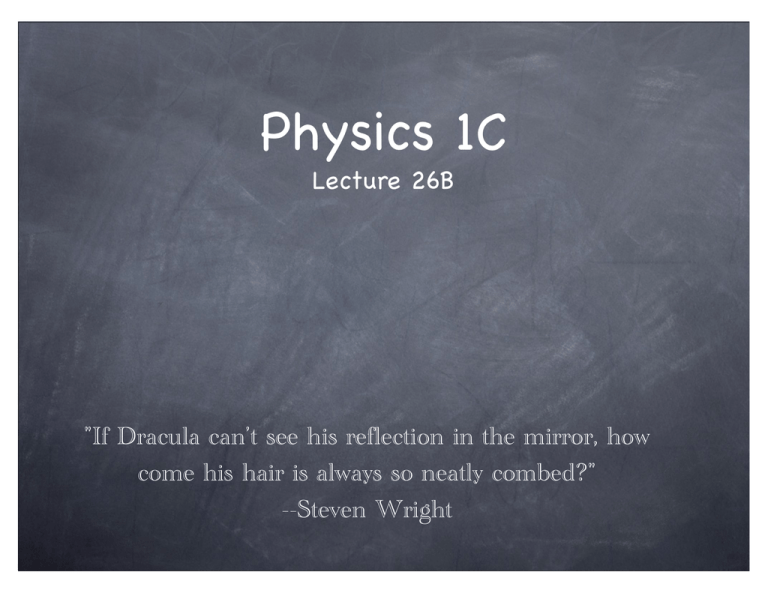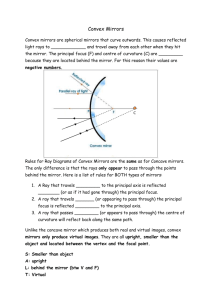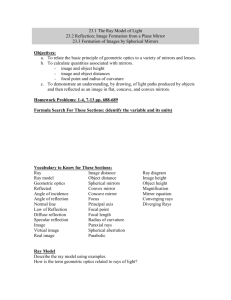Physics 1C
advertisement

Physics 1C Lecture 26B "If Dracula can’t see his reflection in the mirror, how come his hair is always so neatly combed?" --Steven Wright Refracting Surfaces In addition to getting images formed by reflective surfaces, you can also get images formed by refractive surfaces. The equation relating the two distances p and q will be: where p is the distance from the object and the surface and q is between the image and the surface. Refracting Surfaces If the refracting surface is flat, then R is infinite. Then we get: The image is virtual. The image forms between the object and the surface. The rays bend away from the normal since n1 > n2. Refracting Media A small fish is swimming at a depth d below the surface of a pond. So, to the observer the fish appears to be closer to the surface but still in the water. The image is virtual. Mirrors There are different types of mirrors. Spherical mirrors have the shape of a segment of a sphere. Concave spherical mirrors have the reflective part on the inner side of the curve. Convex spherical mirrors have the reflective part on the outer side of the curve. Concave Mirrors For concave mirrors we define the following points: The radius of curvature, R, is the radius of the spherical mirror. The center of curvature, C, is the center of the spherical mirror. Point V is the center of the spherical segment. A line drawn through C to V is called the principle axis. Concave Mirrors If an object is very far away (p=∞), then the incoming light rays are essentially parallel. These light rays will become focused at a single point on the principle axis. In this special case the image will be formed at a point that is 1/2 the distance from the center of the mirror to point C. Concave Mirrors This point is called the focal point, F. The length from the mirror to the focal point is called the focal length, f. The focal length, f, is 1/2 the radius of curvature, R. The focal point is dependent on the curvature of the mirror, not by the location of the object. f = R/2 Concave Mirrors Ray Diagrams A ray diagram can be used to determine the position and size of an image. Ray diagrams are graphical constructions which tell the overall nature of the image. They are an excellent quick way to determine the relative location of the image. You draw three rays with a ray diagram that all start from the same position on the object. The intersection of any two of the rays at a point locates the image (the third ray serves as a logic check). Ray Diagrams Ray 1 is drawn parallel to the principle axis and is reflected back through the focal point, F. Ray 2 is drawn through the focal point and is reflected parallel to the principle axis. Object C F Ray Diagrams Ray 3 is drawn through the center of curvature and is reflected back on itself. Where the three rays converge is where the image will be formed. Image Object C F For this exact situation (object outside the center of curvature) the image is: real, inverted, and diminished. Mirror Equation You can also mathematically relate the object distance, p, and the image distance, q, by using similar triangles. This gives us the following relationship: 1 1 2 + = p q R But since f=R/2, we get: 1 1 1 + = p q f where f is the focal length of the mirror. Mirror Equation The lateral magnification, M, of the image height compared to the object height can also be found geometrically. This gives us the following relationship: h ʹ′ q M = =− h p where the negative sign comes from the fact that h’ is inverted with respect to h. Ray Diagrams The most important thing to remember when dealing with the mirror equations is to remember the sign conventions. For a concave mirror f is +, for a convex mirror f is -. Spherical Mirrors Example A convex spherical mirror of radius of curvature R that is 20.0cm produces an upright image precisely one-quarter the size of an object, a candle. What is the separation distance between the object and its image? Answer The coordinate system is already defined by the sign convention. The center of the mirror is the origin. Spherical Mirrors Answer First, let’s find the focal length of the mirror: R f = = −10.0cm 2 where the negative sign comes from the fact that it is a convex mirror. € The magnification of the object will be: q 1 M =− = p 4 p q=− 4 Next, we can turn to the mirror equation: € 1 1 1 + = p q f € 1 4 1 − = p p f Spherical Mirrors Answer This becomes: 3 1 − = p f p = −3 f = −3(−10cm) = 30cm Then, to find the image distance go back to: € € p 30cm q=− =− = −7.5cm 4 4 Turning to the sign conventions, this means that the object is to the left of the mirror and the image is to the right of the mirror. € So, for the separation distance, just add the two absolute values. s = p + q = 30cm + −7.5cm = 37.5cm Ray Diagrams Let’s check the answer by making a quick ray diagram of the Object situation (with the object distance about 4 times greater than the focal length): Ray 1: parallel. Ray 2: through focal point. Ray 3: through center of curvature. Image F C Image is closer to mirror than the focal point is (1/4 sized). For Next Time (FNT) Finish reading Chapter 26 Start working on the homework for Chapter 26



